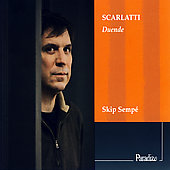Scarlatti: Duende, Harpsichord Sonatas (sempe)
Label: Paradizo Catalog: PA9003 Format: CD Skip Sempé, harpsichord; Olivier Fortin, harpsichordScarlatti: Sonata in E, K 206: Andante; Sonata in D, K 443: Allegro (2 harpsichords); Sonata in f minor, K 462: Andante; Sonata in F, K 256: Andante; Sonata in F, K 6; Sonata in f minor, K 481: Andante e cantabile; Sonata in C, K 423: Presto (2 harpsichords); Sonata in C, K 513: Pastorale; Sonata in C, K 502: Allegro (2 harpsichords); Sonata in b minor, K 87; Sonata in E-flat, K 193: Allegro; Sonata in G minor, K 8: Allegro; Sonata in E-flat, K 253: Allegro; Sonata in D, K 490: Cantabile; Sonata in d minor, K 517: Prestissimo; Sonata in D, K 492: Presto (2 harpsichords); Sonata in d minor, K 32: Aria The third release of Skip Sempé and Capriccio Stravagante new Paradizo label is Duende, Harpsichord Sonatas of Domenico Scarlatti (1685-1757). The recording presents both solo Sonatas and arrangements of Sonatas for two harpsichords. The title of this disc, Duende, appeared in the writings of Federico Garcia Lorca in 1933, and is somewhat related to the 18th century writers on the subject of affect. Duende and virtuosity are both relative to the recognition of the brevity life on earth and the preciousness of time. Garcia Lorca pointed out that Bach and the bullfight can both have duende. And, "Often the duende of the composer passes into the duende of the interpreter". Duende and virtuosity are distinct but inseparable elements of great musical performance. Since the rediscovery of Domenico Scarlatti’s Sonatas in the 19th century and the revival of his keyboard works in the 20th, the influences of Spain on his creativity and musical output have intrigued performers and audiences alike. The interpreter’s task is how to precisely convey these particular elements of Scarlatti’s genius at local colour and folklore. They are associated with melody, harmony, rhythm and their combined gestures, and the manner of identifying them on the harpsichord, at which Scarlatti was quite probably the most pyrotechnical celebrity that ever existed. Scarlatti, with his high risk virtuosity, was the leading gambler performer on the harpsichord in its heyday. The magical sleight of hand which he shared with Frescobaldi, Froberger, Louis Couperin, Bach and Handel begs for interpretive redefinition and even "amplification". The effect is one of further enhancement, providing an alternative of increased dynamic and textural liveliness as well as an enhanced volume level which communicate the raw passion and unbounded virtuosity of the great Neapolitan who, under the spell of Spain’s magic, became Don Domingo Scarlatti. Virtuosity can be identified as an amplification of the musical intentions of a composer or interpreter. The choice of any range of instruments to "amplify" the harpsichord are, quite naturally, also sonic / acoustic. The most natural plucked instrument for effective accompaniment of a solo harpsichord is in fact another harpsichord. Bach worked specifically with this technique in mind when he conceived his Concerti for two, three and four harpsichords. In the Scarlatti Sonatas, the accompanying harpsichord takes the role of a basso continuo section which performs the exact function of amplifying all the gestures and sounds of the soloist, thereby dramatically increasing the overall effect. Skip Sempe’s solid reputation as one of the great harpsichord players of today makes this long awaited release of Scarlatti Sonatas (his first recorded Scarlatti performances) a must for all lovers of the harpsichord, as well as for all admirers mind bending virtuosity. He is joined by Olivier Fortin, already known for his many concerts and recordings of two-harpsichord programmes with Skip Sempé. Duende: A breathtaking disc, alternating poetry, high-risk virtuosity.  Price: $20.98 Price: $20.98 |












